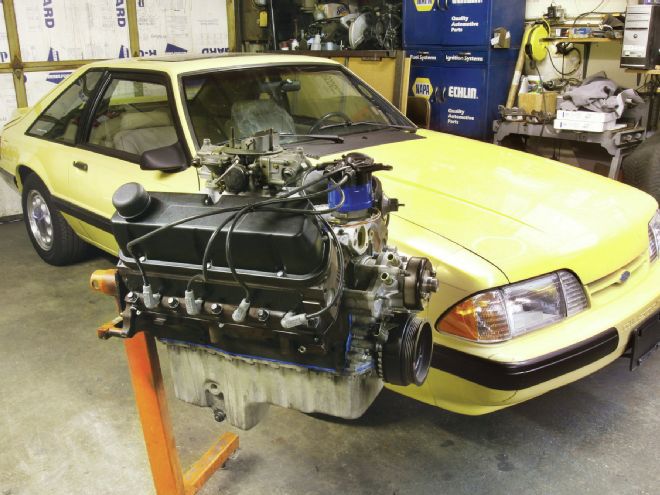
Some ideas never go out of style. It's a classic Car Craft move we've pulled off many times. Yank a motor out of the junkyard, clean it up, add a camshaft, intake, and a carburetor and see how much power we can squeeze out of it. This time around, we chose a shining example of this junkyard art form. Car Craft family member Tim Moore was cruising the 'yard awhile back and located a '00 Ford Explorer with an EFI 5.0L engine. The SUV indicated barely 120,000 on the clock, and after yanking the valve covers to judge the engine's condition, he instantly made the decision to do the boneyard version of a smash-and-grab. Within a few hours of his discovery, the engine was sitting in the back of his truck on its way to a new home.
Beyond the engine's amazingly good appearance, Moore had a couple of good reasons for choosing this engine. The '00 Ford Explorers and Mercury Moutaineers were factory equipped with one of Ford's better 5.0L motors. These engines came with the GT40P head, which even with its small valves, offers really good performance. The engine was only rated at 215 hp but at least had 9.0:1 compression. These cast piston short-blocks are not quite as good as the forged piston 5.0L that came in Fox-body Mustangs, but the GT40P heads flow much better than earlier 5.0L heads. In addition, the cam timing was designed for torque, with duration somewhere around 190 degrees at 0.050 with roughly 0.450-inch lift.
We also discovered some issues with the GT40P heads that required changes, so we added valves from Manley that eliminated the exhaust-valve rotators and allowed us to set the proper valvespring installed height. The heads also required some machine work, including screw-in studs, guideplates, and widening the spring pockets for bigger valvesprings. We took the heads to Mike Slover of Slover's Porting Service in Sun Valley, California, to do this work, plus some basic pocket-porting to improve flow—especially on the exhaust side. We didn't increase the valve size, although we did have to add Manley valves to get the proper spring-installed height. We will go into more detail on the head mods in a later story in Junkyard Builder, so watch for it.
While the heads were off getting a massage, we turned our attention to the cam timing. The question was whether we wanted a torquey small-block or a more cammed-up rpm engine to boost peak horsepower. We decided to test both ideas, so we ordered two roller cams from Lunati: a shorter-duration cam that would deliver decent idle vacuum and maybe make around 320–335 hp, and a longer-duration version that might push the horsepower up to perhaps 350 hp. It turned out we were conservative on both counts.
As a final goal, we decided to bolt on a simple nitrous system and see if we could push this little small-block Ford to make some real power. There are caveats to this plan, however. We've seen what happens from previous Ford experience when power levels above 500 hp tend to either pop head gaskets or saw blocks in half. We decided on a Powerstar kit from Nitrous Supply, owned by our good friend, Mike Thermos, who was one of the original nitrous kit suppliers back in the early '80s. The kit offers adjustable power from 50–250 hp with a simple jet change.
Small-block Fords and Mopars only use four head bolts per cylinder, so retaining proper head-gasket seal—especially with nitrous—is a point that demands attention, so we ordered a set of Fel-Pro MLS head gaskets rather than a standard, composition gasket. The multiple-layer steel construction allows the gasket to conform to movement between the cylinder head and block while maintaining a good seal. They are more expensive than standard head gaskets, but they also do the job and are worth the additional money. For additional insurance, we also added a set of ARP head studs, which are stronger and offer better thread overlap than factory bolts, which helps prevent pulling threads out of a used block.
Finally, we exchanged the Explorer's EFI manifold (which is a pretty good manifold in its own right) for an Edelbrock Performer RPM Air Gap intake and a Holley 750-cfm HP style carburetor. We also added a veteran Ford magnetic pickup distributor and used it to drive an MSD ignition system. With the engine reassembled, we boxed up our second camshaft and headed for Westech's dyno.
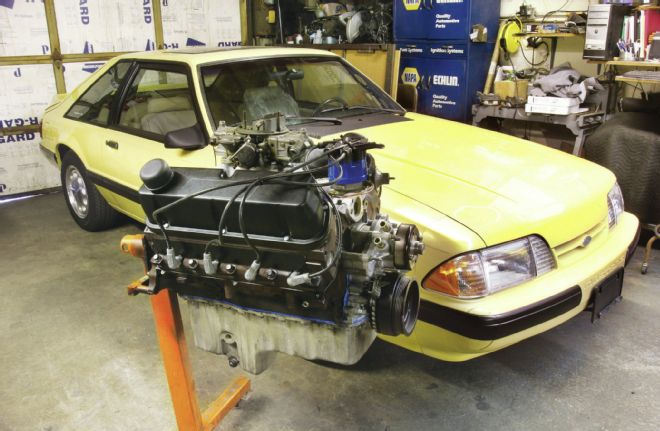
We pulled this hydraulic roller-cammed 5.0L out of a junkyard '96 Ford Explorer, updated the heads, added a carburetor, headers, and a couple roller cams and made as much as 375 hp.
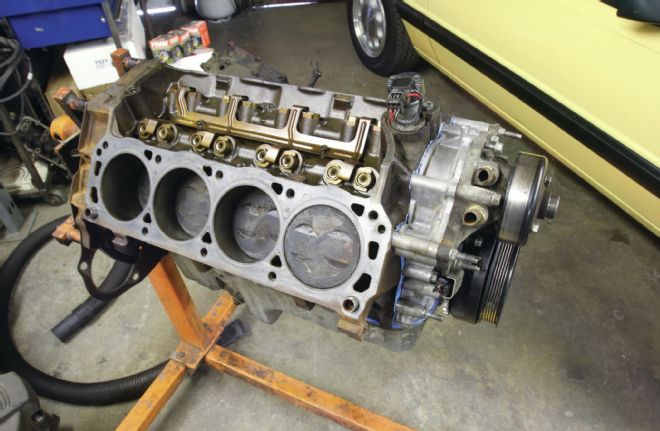
This is the motor with the GT40P head removed. The engine was in extremely good condition considering its mileage—the factory crosshatch was still evident on the cylinder walls. This can be partly attributed to Ford's hard iron block, but more importantly, EFI fuel control and superior lubricants, which help reduce wear.
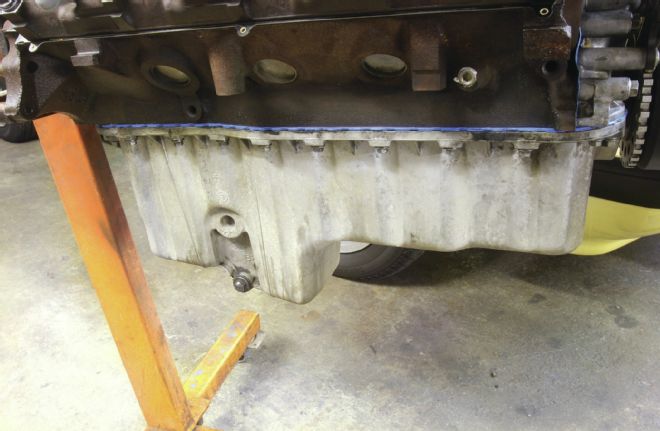
One thing we didn't change on the engine was the original Explorer's uniquely shaped AWD oil pan. If you are plan to swap this 5.0L into a '60s Mustang or even a Fox Mustang, the pan and oil pump pickup will need to be exchanged.
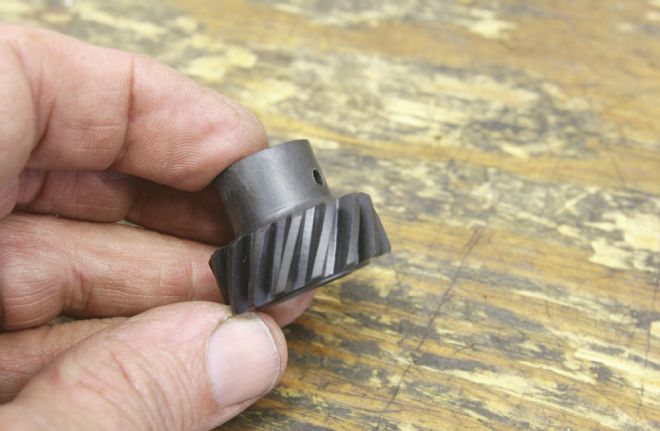
Late-model hydraulic roller 5.0L Ford engines use a steel cam core and a specific Ford distributor drive gear. Since our original engine came with distributorless ignition, Moore swapped in an earlier distributor, which needed a custom gear compatible with the steel core. Comp Cams sells this composite distributor gear that's compatible with all the different cams, but it's pricey. This gear isn't necessary if you're using an aftermarket cam, because they are generally ground on iron cores—like our cams from Lunati—and don't require a custom gear.
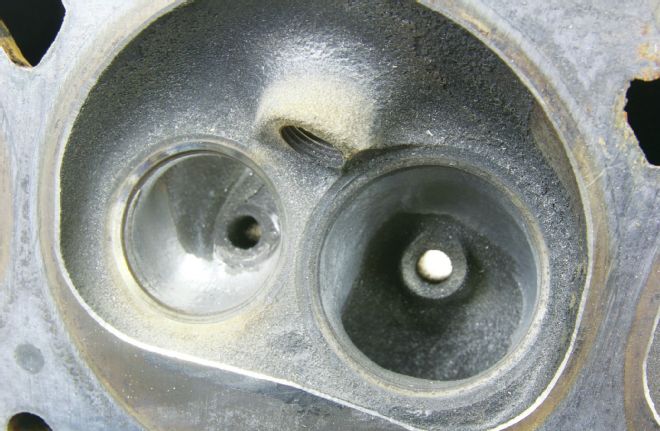
This photo shows Mike concentrating on the bowl area of the heads, but this requires some experience. If you're not familiar with porting, it might be best to leave the work to a professional. Much of the power this engine made on the dyno can attributed to Slover's porting work.
Test Day
We bolted the Ford to the dyno with a set of 15⁄8-inch long-tube headers and an 18-inch collector extension to help the low-speed torque, then we fired the small-block up. For the first test, we were reusing the stock, Explorer cam, so the engine didn't need any break-in time. We we set the timing to 34 degrees and rejetted the carburetor to get our desired 12.5:1 air/fuel ratio. With the tuning finalized, the little cam made far more power than we expected, cranking out 328 lb-ft of torque at 4,200 and 294 hp at 5,400 rpm. We probably could have coaxed an even 300 hp out of this stock configuration, but with such good numbers, we decided to jump right into the first Lunati cam.
The hardest part of swapping the cam was just getting the timing cover off and back on again. The rest went very smoothly, and we reused the stock lifters and suffered no ulcers worrying about breaking in the cam. In less than an hour, we were ready to test. Despite adding 30 degrees of intake duration, this cam improved torque throughout the entire test from 3,000 rpm on up. At 4,300 rpm, the torque peaked at 348 lb-ft, a solid 20–lb-ft improvement, and the Lunati continued to outperform the stock cam all the way through with a peak horsepower increase of 60 hp at 354 hp at 5,700 rpm! Perhaps even more surprising was how well this engine idled, calmly purring with 16 inches of manifold vacuum at 980 rpm. This is a function of the somewhat wider lobe-separation angle of 112 degrees.
This test went so well that we were eager to see what the slightly bigger cam would do. This one added another 10 degrees of duration over the smaller Voodoo cam, along with 0.020-inch more intake valve lift. The longer duration created a slight loss of torque below 3,300 rpm compared to both previous cams, but beyond that mild loss of power, the bigger Voodo out-powered its smaller cousin, cranking out a peak torque of 355 lb-ft at 4,300 (a gain of 7 lb-ft over Test 2) and charging to a peak horsepower of 376 at 6,000 rpm. That's an improvement of 22 hp over Test 2. But what we were most impressed with was the solid gain in torque over the smaller Voodoo cam from 3,500 and up. In a lightweight Fox or early Mustang with a five-speed behind it, this would be a great little street engine. As you might expect with more duration, the idle quality dropped significantly but was still able to make 11.5 inches of vacuum at 980 rpm. That's more than enough to feed a power-brake booster.
For the cherry on top of this Blue Oval desert, we bolted Mike Thermos' simple Powerstar plate nitrous system under the carburetor, installed the 140hp jets (55 fuel and 55 nitrous) and used the trigger to retard the timing on the MSD ignition by 8 degrees. We heated the bottle to 950 psi and hit the button at 4,500 rpm. The dyno recorded a peak horsepower reading of 489 hp, but the air/fuel ratio was slightly on the rich side at 11.5:1, so we increased the nitrous jet to a 61 and hit the button again. This pushed that little Ford to a peak horsepower of 503, and that was where we stopped. Tim's junkyard refugee survived the beating and we had a bitchin' story.
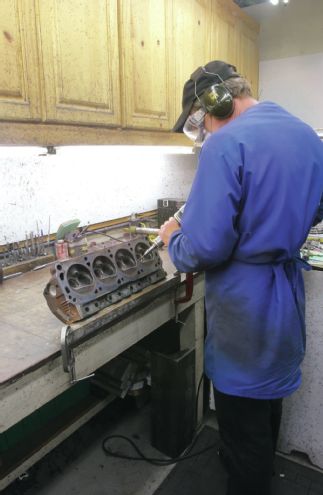
Mike Slover at Slover's Porting Service primarily focused on the exhaust side of the GT40P heads. Even with relatively small valve sizes of 1.85-inch intake and 1.46-inch exhaust, the P-heads flow much better than previous production iron heads and even slightly better than the GT40 castings.
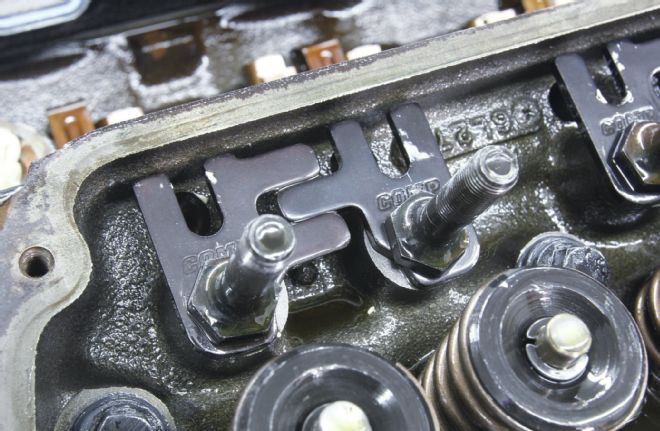
Slover machined the heads for screw-in studs and guideplates since the original configuration used a net lash system that was just too weak. We used Comp's adjustable guideplates to ensure the rockers lined up properly over the valvestems.
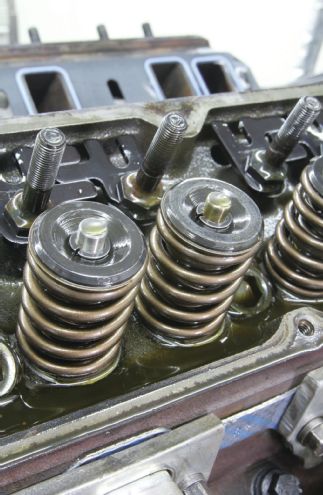
The stock GT40P springs must be upgraded when going to a longer-duration cam. This photo shows the Lunati dual springs we used to ensure valve control at 6,000-rpm-plus engine speeds. They offer 125 pounds on the seat and 325 pounds at 0.600-inch valve lift. These specs are perhaps a bit light, but work because of the Ford's smaller, lighter valves.
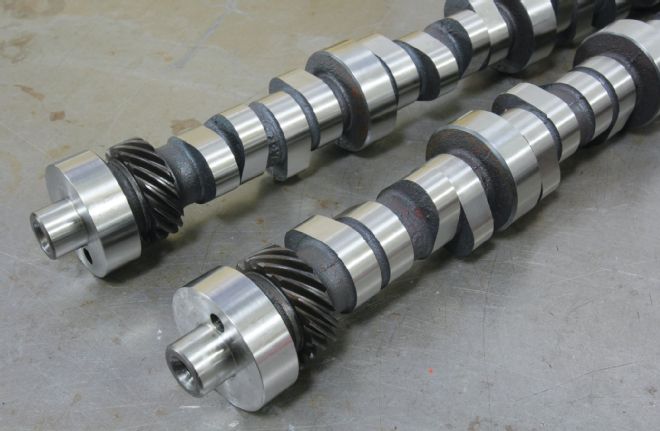
We tried two different Lunati Voodoo hydraulic roller cams. The smaller of the two (221 degrees at 0.050) delivered 30 more degrees of duration on the intake side compared to the stocker. The larger one was still relatively conservative with 231 degrees of duration at 0.050. Both Lunati cams were ground on cast-iron cores, which allowed the use of a stock cast-iron distributor gear.
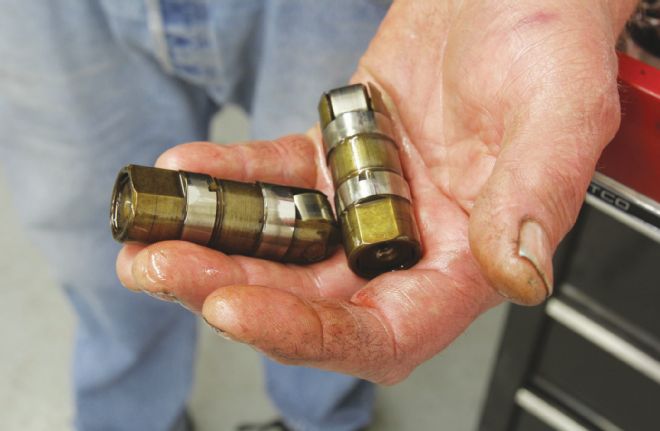
One way to stay within budget on an upgrade like this is to reuse the stock hydraulic roller lifters. Even with stronger valvespring pressure, these lifters worked flawlessly. We were also able to remove the lifters for the cam change without having to remove the heads. Retro-fit hydraulic roller lifters (in earlier non-roller cam blocks) are taller and can't be removed unless you pull the heads.
Conclusions
In review, we rescued a used 5.0L Ford from the boneyard, ported the heads, added a cam, carburetor, intake manifold, and headers and pulled an amazing 376 hp out of the mix. The engine never huffed oil out of the breathers, and the spark plugs all looked excellent. In a 3,250-pound car like a Mustang with 3.50 gears and an automatic with a 2,800-rpm converter, this 5.0L could pull 12.80s at 108 mph. That's fantastic for the minimal investment we made. With nitrous, this is easily a mid-11-second ride. We've already been motivated to put this engine in a buddy's Mustang. Nudge us with emails and we'll make it happen.
Cam Specs
Camshaft Advertised Duration Duration at 0.050 Valve Lift Lobe Sep. Angle Stock 256/266 190/200 (est.) 0.450 NA Lunati – 711 272/280 221/229 0.549/0.565 112 Lunati – 712 282/290 231/239 0.571/0.565 112By the Numbers
We started with a 120,000-mile 5.0L out of a Ford Explorer, removed the EFI and DIS and pocket ported the stock GT40P iron heads with stock valve sizes. We also added an Edelbrock Performer RPM dual-plane intake and a set of 15⁄8-inch headers with no mufflers. The HP DIFF column on the far right lists the horsepower difference between Test 1 and Test 3. The asterisk HP differences are calculated using Test 1's 294hp peak.
•Test 1:750-cfm carburetor, dual-plane intake manifold, and stock camshaft.
•Test 2:Changed to the smaller of the two Lunati camshafts—no other changes.
•Test 3:Installed the larger Lunati cam—again, no other changes.
Parts List
Description PN Source Price Used 5.0L Ford engine N-A Junkyard $350.00 Edelbrock Perf. RPM intake 7521 Summit Racing 289.97 Holley 750-cfm mech. sec. 0-4779 Swap Meet 250.00 Lunati camshaft, hyd. roller, small 20350711 Summit Racing 299.97 Lunati camshaft, hyd. roller, big 20350712 Summit Racing 299.97 Lunati rocker arms, 1.6:1 15385-16 Summit Racing 264.97 Lunati timing chain set 94251 Summit Racing 43.97 Lunati pushrod set 80745-16 Summit Racing 35.97 Lunati valvesprings, 1.450 dia. 73100-16 Summit Racing 129.97 Manley exhaust valves 10723-8 Summit Racing 132.97 Comp Cams 3/8 rocker stud 4515 Summit Racing 59.97 Comp Cams guide plates, flat 4816-8 Summit Racing 17.19 Comp Cams guide plates, adj. 4835-8 Summit Racing 54.97 Comp Cams composite gear 35200 Summit Racing 114.97 Comp Muscle car oil, qt 1594 Summit Racing 8.97 (ea) Nitrous Supply Powerstar kit 03001 Nitrous Supply 603.75 ARP head bolts 154-3601 Summit Racing 49.86 ARP intake bolts 154-2001 Summit Racing 28.97 Fel-Pro head gasket, MLS 1133 Summit Racing 60.97 (ea.) Fel-Pro head gasket, composition 10111 Summit Racing 29.97 (ea.) Fel-Pro intake gasket, stock port 1250 Summit Racing 20.97 Fel-Pro valve cover gasket VS50029C Summit Racing 13.97 Fel-Pro timing cover gasket TCS45449 Summit Racing 12.97 Fel-Pro water pump gasket 35352 Summit Racing 1.97 MSD spark-plug wire kit, black 31183 Summit Racing 85.97 Autolite spark plugs (8) 764 Summit Racing 23.92 Autolite spark plugs, race (8) AR472 Summit Racing 39.76 Fram oil filter, ultra synthetic XG2 Summit Racing 8.97 Comp Cams 10W30 oil, 5 qts. 1594 Summit Racing 8.97 (ea.) Labor Labor to port cylinder heads NA Slover Porting 325.00 Machine for studs and guideplates NA Slover Porting 140.00 Machine spring pockets NA Slover Porting 65.00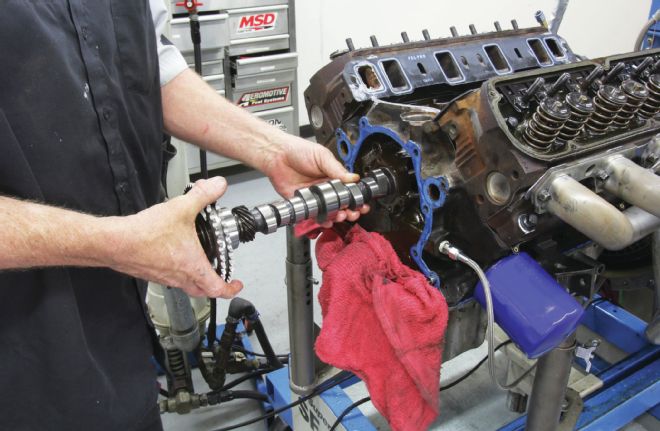
Changing cams in the 5.0L was easy. Don't forget to install the limiter plate on the block before installing the cam gear. It's also critical to install the dog bones over the hydraulic roller lifters with the dot facing up. This will properly retain the lifters. If the dog bones are installed upside-down, this could cause massive cam damage if the lifters are allowed to spin. Don't make that mistake.
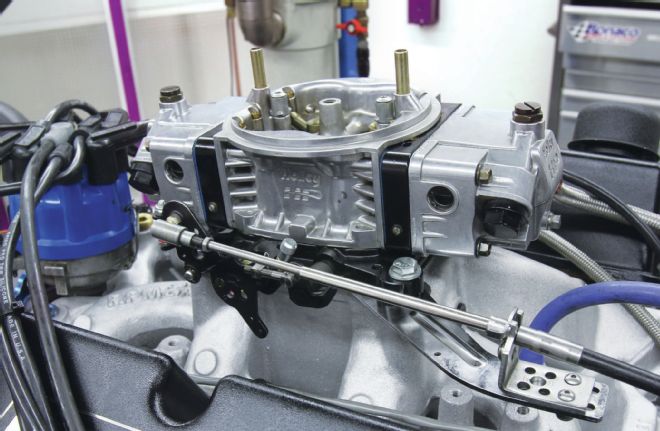
For the induction side of our test, we used an Edelbrock Performer RPM Air Gap dual-plane intake combined with a Holey 750-cfm mechanical secondary carburetor. Because this engine only made 375 hp, we might have made the same power with a smaller 650-cfm carb.
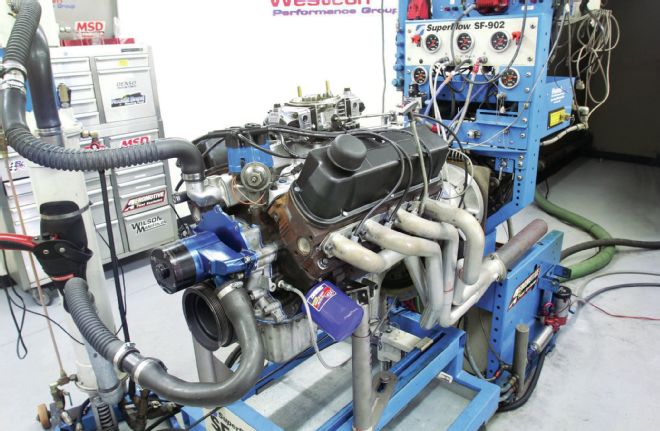
Dyno testing the 302 didn't require a significant amount of tuning. We rejetted the Holley 750 leaner by two jets sizes in the primary to stabilize the air/fuel ratio at around 12.5:1 throughout most of the pull. The tight combustion chamber only wanted 34 degrees of timing for best power. When we added timing, it lost power.
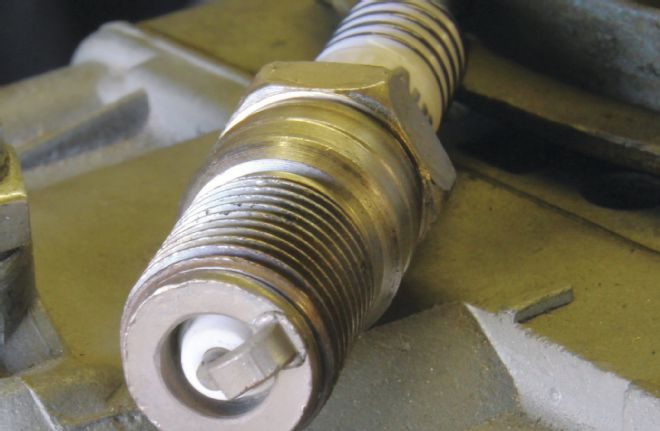
We used a set of colder Autolite race plugs with a non-projected nose for the nitrous. You can't see it in this photo because the evidence is very faint, but this plug revealed evidence of detonation with a few very small black specs on the porcelain. Detonation occurred even though we pulled 8 degrees of timing with the nitrous engaged. This means we were right on the edge. It's possible that pulling 10 degrees of timing might have made more power.
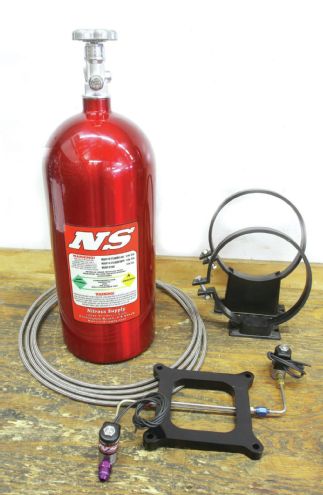
We used Nitrous Supply's entry-level Powerstar kit, which is adjustable from 50–250 hp. You can also easily upgrade this system by adding a larger nitrous solenoid since the fuel solenoid is capable of delivering fuel up to 400 hp. The plate is the same one used in larger kits.